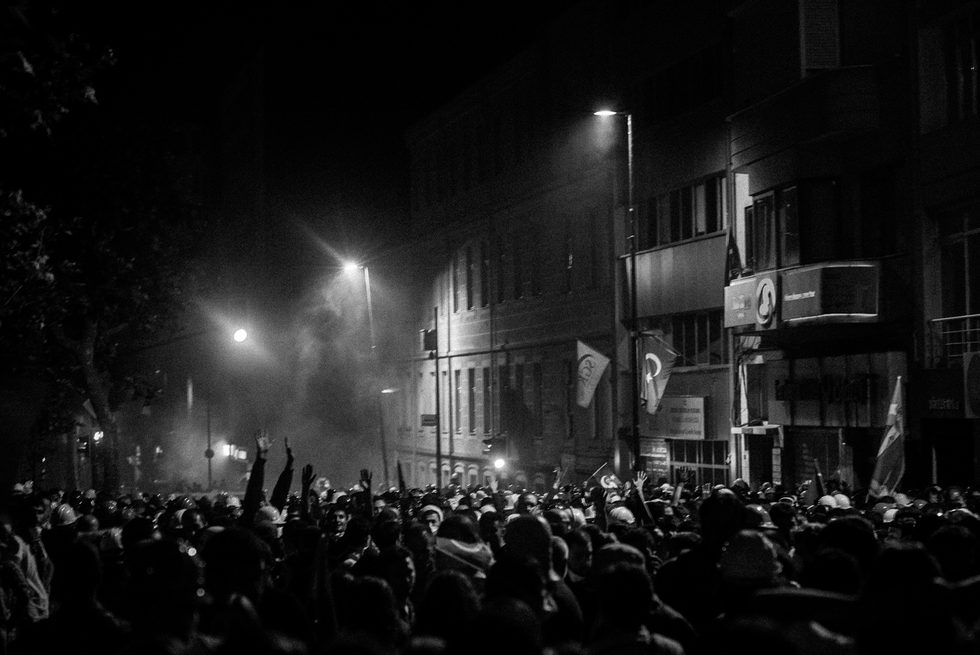The Politics of Humor and Humor as Politics during Turkey’s Gezi Park Protests
From the Series: An Impromptu Uprising: Ethnographic Reflections on the Gezi Park Protests in Turkey
From the Series: An Impromptu Uprising: Ethnographic Reflections on the Gezi Park Protests in Turkey


Can humor be the language of resistance when “resistance” also means people being tear gassed, shot at, blinded, and killed by the police and counter-demonstrators? This became a burning question for me when a small-scale demonstration against the demolition of the Taksim Gezi Park in Istanbul turned into a wider resistance against the Turkish government’s neoliberal and increasingly authoritarian policies. During this process, the streets and the screens were saturated with satirical images, statements, and performances ridiculing the police, politicians, and the media. Expanding the range of the “publicly expressible” in times of fear, despair, and dissatisfaction with the existing order, humor during the Gezi events formed a language that was unexpected yet ordinary, entertaining yet deeply political. This language compelled its users and audience to think beyond existing social frameworks of public expression and formed a political presence unprecedented in Turkey’s history.
Consider image 2, in which the protestors are mocking the police who, during the protests, covered the numbers on their helmets with water bottle labels in order to avoid being identified while in action (image 3). The funnel on the head is a widespread metaphor in Turkey used by cartoonists to represent “the mad” and signifies the humor in their “out-of-place” yet intelligent comments. Evoking the thin line between “madness” and “intelligence” that these cartoons play with, this parody encourages resistance in denial of sanity when everything about the state becomes utterly insane.


Or take the stencil that depicts PM Erdoğan smiling and posing for protestors to take a photograph as “a memory of the resistance” [Direniş Hatırası] (image 4). Given Erdoğan’s infamously condescending rhetoric in his public statements about the protestors, the portrayal of this friendlier act of “patronizing” locates its humor in the very disjuncture between “the real” and its impossible replica.

In both the examples above, parody serves as an aesthetic of wit, bemusement, and playfulness modeled on the original (Marcus 1988, 71), yet overturning it by calling its terms into question. As we laugh and invite others to laugh at the ridiculousness of the “real,” we also reveal the latter’s objectionable nature. “We laugh,” in Bataille’s (1986, 90) words, “in passing very abruptly from a world in which everything is firmly qualified, in which everything is given as stable within a generally stable order, into a world in which our assurance is overwhelmed, in which we perceive that this assurance was deceptive.” The political power of humor resides partly in this departure from the normal order and the expectations that are attached to this order.
Such departure requires one to engage critically not only with reality but also with the very act of representing it, which often brings one to the realm of misrepresentations, censorship, and self-censorship. The penguin documentary that the local channel CNN Turk was broadcasting when Taksim was under tear gas on May 31, 2013, provoked such an engagement. Images of resisting penguins (images 5–7) juxtaposed to the aggression in the streets transformed the penguin from the media’s way of concealing the reality into a means to expose this concealment. By inducing laughter, they destabilized the truth claims of “real” news reportage.



Parody, like mimicry, is “at once resemblance and menace” (Bhabha 1994, 88). While it reinforces the validity of what it mocks, it also renders the unexpected appearance of bodies in public impervious to labeling, categorization, and re-appropriation by those in power. Humor does more than “express” what has already been articulated in other political domains. It creates a bond among those who share “the dark knowledge and experience that underlie the parody” (Bernal 2013, 308), and cultivates a vocabulary through which the protestors are able to distinguish their voice from that of the government, even when they speak to and imitate the latter. One only needs to remember how quickly Erdoğan’s use of the word çapulcu to describe the protestors as “looters” went viral as something laughable, was reclaimed, identified with, and turned into a neologism in many languages to refer to, “fighting for one’s rights” (images 8–10).1



This humorous language was found mostly amongst urban youth and was criticized by some constituents of the resistance as depoliticizing and pacifying. When its object of ridicule shifted from the government to its supporters, it also became more prone to humiliating and offending certain segments of society than creating political critique. Humor nevertheless proved to be more than creative enjoyment during the Gezi Park protests and served as an alternative medium for political communication about the “serious world” that it emanates from yet refuses to accept at face value.
1. See the recently-opened Wikipedia page for the term “chapulling” for details of this act of re-appropriation.
George Bataille, Writings on Laughter, Sacrifice, Nietzsche, Un-Knowing. Cambridge, Mass.: MIT Press, 1986.
Victoria Bernal, “Please Forget Democracy and Justice: Eritrean Politics and the Powers of Humor,” American Ethnologist 40, no. 2 (2013): 300–309.
Homi Bhabha, The Location of Culture. New York: Routledge, 1994.
George Marcus, “Parody and the Parodic in Polynesian Cultural History,” Cultural Anthropology 3, no. 1 (1988): 68–76.